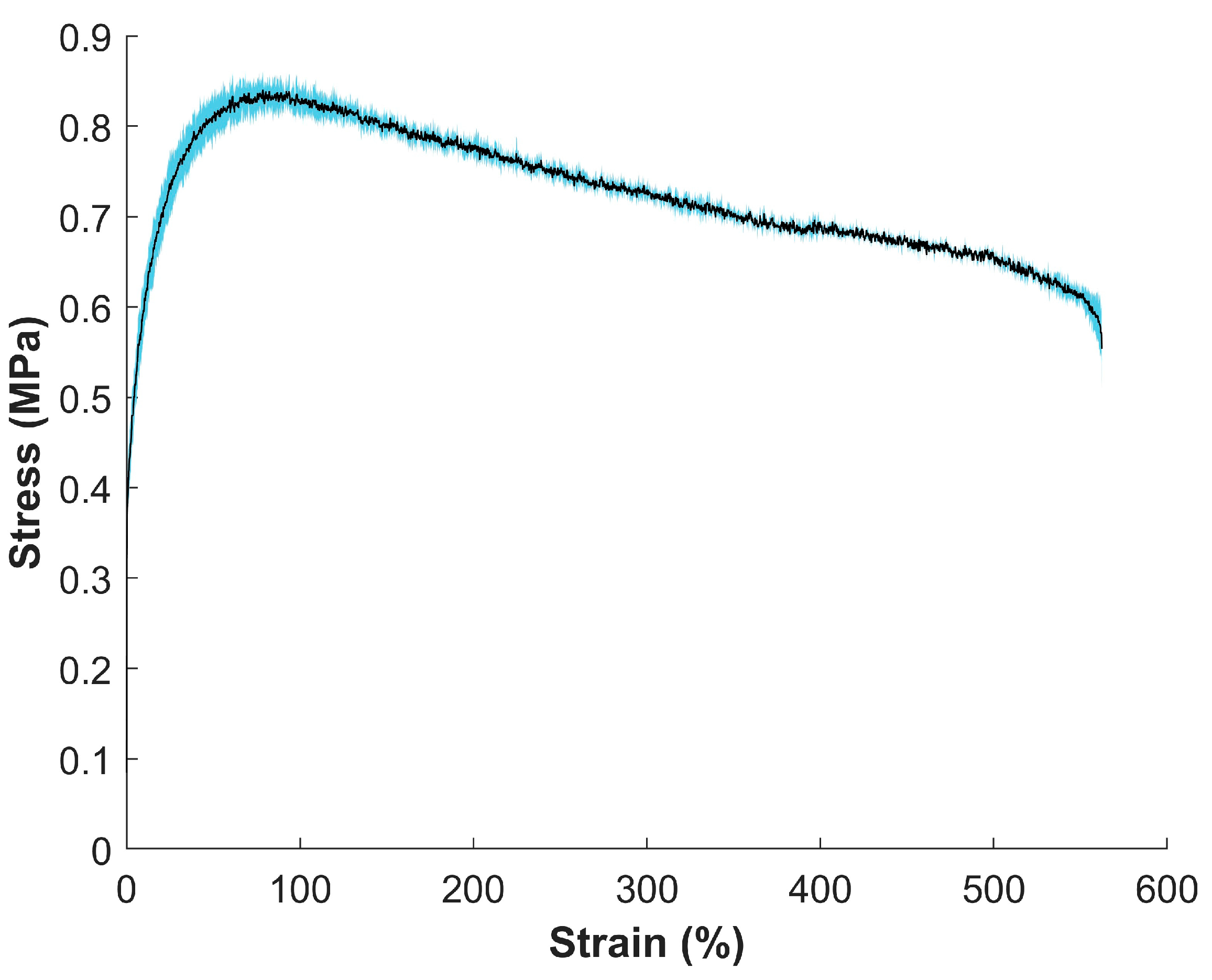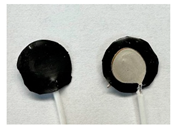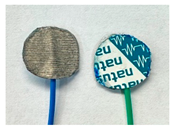Benchtop Performance of Novel Mixed Ionic–Electronic Conductive Electrode Form Factors for Biopotential Recordings
Abstract
:1. Introduction
2. Materials and Methods
2.1. Electrode Fabrication
- MIEC casted on stainless steel (SS): MIEC-coated SS electrodes;
- MIEC foam: MIEC foam electrodes;
- MIEC sheet on silver (Ag) epoxy: MIEC elastomeric sheet connected with a flexible Ag epoxy backing;
- MIEC fabric: MIEC fabric electrodes that have the potential to be integrated into many textiles.
2.1.1. Fabrication of MIEC Slurry Masterbatch
2.1.2. Fabrication of Electrode Form Factors
2.1.3. Synthetic Skin Fabrication
2.2. Electrode–Skin Interfacial Charge-Transfer Characterization via Electrical Impedance Spectroscopy (EIS)
2.3. Ground-Truth Biopotential Measurement Using an Electrical Phantom
2.4. Mechanical Properties: Tensile Test
2.5. Scanning Electron Microscopy
3. Results
3.1. Impedance Measurements
3.2. Artificial EMG Signaling SNR
3.3. Interfacial Charge Transfer of Electrodes
3.4. Mechanical Properties of MIEC Sheet
3.5. SEM Imaging
4. Discussion
4.1. Impedance and Interfacial Charge-Transfer Properties of Electrodes
4.2. Signal Quality—SNR (Limited to EMG Recording)
4.3. Relationship of Interfacial Charge Transfer to SNR
4.4. Mechanical Strength of MIEC Material
4.5. SEM Analysis of MIEC Sheets
4.6. Other Potential Signal Acquisition Applications
4.7. Future Directions
4.8. Study Limitations
4.9. Concluding Remarks
Author Contributions
Funding
Institutional Review Board Statement
Informed Consent Statement
Data Availability Statement
Acknowledgments
Conflicts of Interest
References
- Salvo, P.; Pingitore, A.; Barbini, A.; Di Francesco, F. A wearable sweat rate sensor to monitor the athletes’ performance during training. Sci. Sports 2018, 33, e51–e58. [Google Scholar] [CrossRef]
- Li, R.T.; Kling, S.R.; Salata, M.J.; Cupp, S.A.; Sheehan, J.; Voos, J.E. Wearable performance devices in sports medicine. Sports Health 2016, 8, 74–78. [Google Scholar] [CrossRef]
- Majumder, S.; Mondal, T.; Deen, M.J. Wearable sensors for remote health monitoring. Sensors 2017, 17, 130. [Google Scholar] [CrossRef]
- Rodgers, M.M.; Pai, V.M.; Conroy, R.S. Recent advances in wearable sensors for health monitoring. IEEE Sens. J. 2014, 15, 3119–3126. [Google Scholar] [CrossRef]
- Valliappan, S.; Mohan, B.P.R.; Kumar, S.R. Design of low-cost, wearable remote health monitoring and alert system for elderly heart patients. In Proceedings of the 2017 International Conference on IoT and Application (ICIOT), Nagapattinam, India, 19–20 May 2017; IEEE: New York, NY, USA, 2017. [Google Scholar]
- Albulbul, A. Evaluating major electrode types for idle biological signal measurements for modern medical technology. Bioengineering 2016, 3, 20. [Google Scholar] [CrossRef] [PubMed]
- McAdams, E. Bioelectrodes. In Encyclopedia of Medical Devices and Instrumentation; Wiley: New York, NY, USA, 2006. [Google Scholar]
- Kim, H.; Kim, E.; Choi, C.; Yeo, W.-H. Advances in soft and dry electrodes for wearable health monitoring devices. Micromachines 2022, 13, 629. [Google Scholar] [CrossRef]
- Shinwari, M.W.; Zhitomirsky, D.; Deen, I.A.; Selvaganapathy, P.R.; Deen, M.J.; Landheer, D. Microfabricated reference electrodes and their biosensing applications. Sensors 2010, 10, 1679–1715. [Google Scholar] [CrossRef] [PubMed]
- Fu, Y.; Zhao, J.; Dong, Y.; Wang, X. Dry electrodes for human bioelectrical signal monitoring. Sensors 2020, 20, 3651. [Google Scholar] [CrossRef] [PubMed]
- Lopez-Gordo, M.A.; Sanchez-Morillo, D.; Valle, F.P. Dry EEG electrodes. Sensors 2014, 14, 12847–12870. [Google Scholar] [CrossRef]
- Gruetzmann, A.; Hansen, S.; Müller, J. Novel dry electrodes for ECG monitoring. Physiol. Meas. 2007, 28, 1375. [Google Scholar] [CrossRef]
- Laferriere, P.; Lemaire, E.D.; Chan, A.D. Surface electromyographic signals using dry electrodes. IEEE Trans. Instrum. Meas. 2011, 60, 3259–3268. [Google Scholar] [CrossRef]
- Liu, Q.; Yang, L.; Zhang, Z.; Yang, H.; Zhang, Y.; Wu, J. The Feature, Performance, and Prospect of Advanced Electrodes for Electroencephalogram. Biosensors 2023, 13, 101. [Google Scholar] [CrossRef] [PubMed]
- Kim, H.; Rho, S.; Han, S.; Lim, D.; Jeong, W. Fabrication of Textile-Based Dry Electrode and Analysis of Its Surface EMG Signal for Applying Smart Wear. Polymers 2022, 14, 3641. [Google Scholar] [CrossRef] [PubMed]
- O’Sullivan, M.; Temko, A.; Bocchino, A.; O’Mahony, C.; Boylan, G.; Popovici, E. Analysis of a low-cost EEG monitoring system and dry electrodes toward clinical use in the neonatal ICU. Sensors 2019, 19, 2637. [Google Scholar] [CrossRef] [PubMed]
- Vidhya, C.; Maithani, Y.; Singh, J.P. Recent advances and challenges in textile electrodes for wearable biopotential signal monitoring: A comprehensive review. Biosensors 2023, 13, 679. [Google Scholar] [CrossRef] [PubMed]
- Ren, L.; Jiang, Q.; Chen, Z.; Chen, K.; Xu, S.; Gao, J.; Jiang, L. Flexible microneedle array electrode using magnetorheological drawing lithography for bio-signal monitoring. Sens. Actuators A Phys. 2017, 268, 38–45. [Google Scholar] [CrossRef]
- Lee, E.K.; Baruah, R.K.; Bhamra, H.; Kim, Y.-J.; Yoo, H. Recent advances in electrode development for biomedical applications. Biomed. Eng. Lett. 2021, 11, 107–115. [Google Scholar] [CrossRef] [PubMed]
- Li, G.; Wu, J.; Xia, Y.; Wu, Y.; Tian, Y.; Liu, J.; Chen, D.; He, Q. Towards emerging EEG applications: A novel printable flexible Ag/AgCl dry electrode array for robust recording of EEG signals at forehead sites. J. Neural Eng. 2020, 17, 026001. [Google Scholar] [CrossRef] [PubMed]
- Liu, J.; Liu, M.; Bai, Y.; Zhang, J.; Liu, H.; Zhu, W. Recent progress in flexible wearable sensors for vital sign monitoring. Sensors 2020, 20, 4009. [Google Scholar] [CrossRef]
- Colachis, M.; Shqau, K.; Colachis IV, S.; Annetta, N.; Heintz, A.M. Soft mixed ionic–electronic conductive electrodes for noninvasive stimulation. J. Appl. Polym. Sci. 2020, 137, 48998. [Google Scholar] [CrossRef]
- Ganesh, E. Single walled and multi walled carbon nanotube structure, synthesis and applications. Int. J. Innov. Technol. Explor. Eng. 2013, 2, 311–320. [Google Scholar]
- Andrews, R.; Jacques, D.; Qian, D.; Rantell, T. Multiwall carbon nanotubes: Synthesis and application. Acc. Chem. Res. 2002, 35, 1008–1017. [Google Scholar] [CrossRef]
- Lehman, J.H.; Terrones, M.; Mansfield, E.; Hurst, K.E.; Meunier, V. Evaluating the characteristics of multiwall carbon nanotubes. Carbon 2011, 49, 2581–2602. [Google Scholar] [CrossRef]
- Moisala, A.; Li, Q.; Kinloch, I.; Windle, A. Thermal and electrical conductivity of single-and multi-walled carbon nanotube-epoxy composites. Compos. Sci. Technol. 2006, 66, 1285–1288. [Google Scholar] [CrossRef]
- Hirlekar, R.; Yamagar, M.; Garse, H.; Vij, M.; Kadam, V. Carbon nanotubes and its applications: A review. Asian J. Pharm. Clin. Res. 2009, 2, 17–27. [Google Scholar]
- Tran, H.; Feig, V.R.; Liu, K.; Zheng, Y.; Bao, Z. Polymer chemistries underpinning materials for skin-inspired electronics. Macromolecules 2019, 52, 3965–3974. [Google Scholar] [CrossRef]
- Winand, J.-M.; Depireux, J. Measurement of ionic conductivity in solid electrolytes. Europhys. Lett. 1989, 8, 447. [Google Scholar] [CrossRef]
- Li, J.; Ma, P.C.; Chow, W.S.; To, C.K.; Tang, B.Z.; Kim, J.K. Correlations between percolation threshold, dispersion state, and aspect ratio of carbon nanotubes. Adv. Funct. Mater. 2007, 17, 3207–3215. [Google Scholar] [CrossRef]
- Mora, A.; Han, F.; Lubineau, G. Estimating and understanding the efficiency of nanoparticles in enhancing the conductivity of carbon nanotube/polymer composites. Results Phys. 2018, 10, 81–90. [Google Scholar] [CrossRef]
- Schlink, B.R.; Ferris, D.P. A lower limb phantom for simulation and assessment of electromyography technology. IEEE Trans. Neural Syst. Rehabil. Eng. 2019, 27, 2378–2385. [Google Scholar] [CrossRef]
- Lam, E.; Alizadeh-Meghrazi, M.; Schlums, A.; Eskandarian, L.; Mahnam, A.; Moineau, B.; Popovic, M.R. Exploring textile-based electrode materials for electromyography smart garments. J. Rehabil. Assist. Technol. Eng. 2022, 9, 20556683211061995. [Google Scholar] [CrossRef] [PubMed]
- Roo, A. Enabling Professional Intervention Points for the Process of Stroke Rehabilitation. Ph.D. Thesis, The Ohio State University, Columbus, OH, USA, 2023. [Google Scholar]
- Meyers, E.; Gabrieli, D.; Wengerd, L.; Darrow, M.; Friedenberg, D. Decoding hand and Wrist Movement Intention from Chronic Stroke Survivors with Hemiparesis Using A Wearable, User-Centric Neural Interface. Arch. Phys. Med. Rehabil. 2022, 103, e14–e15. [Google Scholar] [CrossRef]
- Lisdat, F.; Schäfer, D. The use of electrochemical impedance spectroscopy for biosensing. Anal. Bioanal. Chem. 2008, 391, 1555–1567. [Google Scholar] [CrossRef]
- Yao, S.; Zhu, Y. Nanomaterial-enabled dry electrodes for electrophysiological sensing: A review. Jom 2016, 68, 1145–1155. [Google Scholar] [CrossRef]
- Alizadeh-Meghrazi, M.; Ying, B.; Schlums, A.; Lam, E.; Eskandarian, L.; Abbas, F.; Sidhu, G.; Mahnam, A.; Moineau, B.; Popovic, M.R. Evaluation of dry textile electrodes for long-term electrocardiographic monitoring. Biomed. Eng. Online 2021, 20, 68. [Google Scholar] [CrossRef] [PubMed]
- Owda, A.Y.; Casson, A.J. Electrical properties, accuracy, and multi-day performance of gelatine phantoms for electrophysiology. BioRxiv 2020, biorxiv:2020.05.30.125070. [Google Scholar]
- De Luca, C.J.; Kuznetsov, M.; Gilmore, L.D.; Roy, S.H. Inter-electrode spacing of surface EMG sensors: Reduction of crosstalk contamination during voluntary contractions. J. Biomech. 2012, 45, 555–561. [Google Scholar] [CrossRef]
- Merlo, A.; Bò, M.C.; Campanini, I. Electrode size and placement for surface emg bipolar detection from the brachioradialis muscle: A scoping review. Sensors 2021, 21, 7322. [Google Scholar] [CrossRef]
- Vieira, T.M.; Cerone, G.L.; Botter, A.; Watanabe, K.; Vigotsky, A.D. The sensitivity of bipolar electromyograms to muscle excitation scales with the inter-electrode distance. IEEE Trans. Neural Syst. Rehabil. Eng. 2023, 31, 4245–4255. [Google Scholar] [CrossRef]
- Meyers, E.C.; Gabrieli, D.; Tacca, N.; Wengerd, L.; Darrow, M.; Friedenberg, D. Decoding hand and wrist movement intention from chronic stroke survivors with hemiparesis using a user-friendly, wearable EMG-based neural interface. medRxiv 2021, medRxiv:2021.09.07.21262896. [Google Scholar]
- ASTM D3577; Standard Specification for Rubber Surgical Gloves. ASTM International: West Conshohocken, PA, USA, 2023.
- De Luca, C.J. Surface electromyography: Detection and recording. DelSys Inc. 2002, 10, 1–10. [Google Scholar]
- Yang, L.; Gan, L.; Zhang, Z.; Zhang, Z.; Yang, H.; Zhang, Y.; Wu, J. Insight into the contact impedance between the electrode and the skin surface for electrophysical recordings. ACS Omega 2022, 7, 13906–13912. [Google Scholar] [CrossRef]
- Macdonald, J.R. Impedance spectroscopy. Ann. Biomed. Eng. 1992, 20, 289–305. [Google Scholar] [CrossRef]
- Bounik, R.; Cardes, F.; Ulusan, H.; Modena, M.M.; Hierlemann, A. Impedance imaging of cells and tissues: Design and applications. BME Front. 2022, 2022, 9857485. [Google Scholar] [CrossRef] [PubMed]
- Li, G.; Wang, S.; Duan, Y.Y. Towards conductive-gel-free electrodes: Understanding the wet electrode, semi-dry electrode and dry electrode-skin interface impedance using electrochemical impedance spectroscopy fitting. Sens. Actuators B Chem. 2018, 277, 250–260. [Google Scholar] [CrossRef]
- Lee, M.S.; Paul, A.; Xu, Y.; Hairston, W.D.; Cauwenberghs, G. Characterization of Ag/AgCl dry electrodes for wearable electrophysiological sensing. Front. Electron. 2022, 2, 700363. [Google Scholar] [CrossRef]
- Ng, C.L.; Reaz, M.B.I. Characterization of textile-insulated capacitive biosensors. Sensors 2017, 17, 574. [Google Scholar] [CrossRef]
- Lazanas, A.C.; Prodromidis, M.I. Electrochemical Impedance Spectroscopy—A Tutorial. ACS Meas. Sci. Au 2023, 3, 162–193. [Google Scholar] [CrossRef]
- Daniels, J.S.; Pourmand, N. Label-free impedance biosensors: Opportunities and challenges. Electroanal. Int. J. Devoted Fundam. Pract. Asp. Electroanal. 2007, 19, 1239–1257. [Google Scholar] [CrossRef] [PubMed]
- Schwan, H. Linear and nonlinear electrode polarization and biological materials. Ann. Biomed. Eng. 1992, 20, 269–288. [Google Scholar] [CrossRef]
- Lopes, P.A.; Vaz Gomes, D.; Green Marques, D.; Faia, P.; Góis, J.; Patrício, T.F.; Coelho, J.; Serra, A.; de Almeida, A.T.; Majidi, C. Soft bioelectronic stickers: Selection and evaluation of skin-interfacing electrodes. Adv. Healthc. Mater. 2019, 8, 1900234. [Google Scholar] [CrossRef]
- Kim, S.; Lee, S.; Jeong, W. EMG measurement with textile-based electrodes in different electrode sizes and clothing pressures for smart clothing design optimization. Polymers 2020, 12, 2406. [Google Scholar] [CrossRef] [PubMed]
- Tanzer, I.O.; Järvenpää, S.; Nenonen, J.; Somersalo, E. Representation of bioelectric current sources using Whitney elements in the finite element method. Phys. Med. Biol. 2005, 50, 3023. [Google Scholar] [CrossRef]
- Cogan, S.F. Neural stimulation and recording electrodes. Annu. Rev. Biomed. Eng 2008, 10, 275–309. [Google Scholar] [CrossRef]
- Castagnola, E.; Ansaldo, A.; Maggiolini, E.; Ius, T.; Skrap, M.; Ricci, D.; Fadiga, L. Smaller, softer, lower-impedance electrodes for human neuroprosthesis: A pragmatic approach. Front. Neuroeng. 2014, 7, 8. [Google Scholar] [CrossRef]
- Gallagher, A.; Ní Annaidh, A.; Bruyère, K.; Otténio, M.; Xie, H.; Gilchrist, M. Dynamic tensile properties of human skin. In Proceedings of the IRCOBI Conference 2012, Dublin, Ireland, 12–14 September 2012; International Research Council on the Biomechanics of Injury: Stockholm, Sweden, 2012. [Google Scholar]
- Kalra, A.; Lowe, A.; Al-Jumaily, A. Mechanical behaviour of skin: A review. J. Mater. Sci. Eng 2016, 5, 1000254. [Google Scholar]
- Shi, Y.; Fu, X.; Wang, W.; Yu, D. Stretchable, adhesive and low impedance hydrogel prepared by one-pot method used as ECG electrodes. Colloids Surf. A Physicochem. Eng. Asp. 2023, 662, 130998. [Google Scholar] [CrossRef]
- Clark, J.; Cheng, J.; Leung, K. Mechanical properties of normal skin and hypertrophic scars. Burns 1996, 22, 443–446. [Google Scholar] [CrossRef] [PubMed]
- Ciancibello, J.; King, K.; Meghrazi, M.A.; Padmanaban, S.; Levy, T.; Ramdeo, R.; Straka, M.; Bouton, C. Closed-loop neuromuscular electrical stimulation using feedforward-feedback control and textile electrodes to regulate grasp force in quadriplegia. Bioelectron. Med. 2019, 5, 19. [Google Scholar] [CrossRef] [PubMed]
- Alizadeh-Meghrazi, M.; Sidhu, G.; Jain, S.; Stone, M.; Eskandarian, L.; Toossi, A.; Popovic, M.R. A mass-producible washable smart garment with embedded textile EMG electrodes for control of myoelectric prostheses: A pilot study. Sensors 2022, 22, 666. [Google Scholar] [CrossRef]
- Moineau, B.; Marquez-Chin, C.; Alizadeh-Meghrazi, M.; Popovic, M.R. Garments for functional electrical stimulation: Design and proofs of concept. J. Rehabil. Assist. Technol. Eng. 2019, 6, 2055668319854340. [Google Scholar] [CrossRef]
- Acar, G.; Ozturk, O.; Golparvar, A.J.; Elboshra, T.A.; Böhringer, K.; Yapici, M.K. Wearable and flexible textile electrodes for biopotential signal monitoring: A review. Electronics 2019, 8, 479. [Google Scholar] [CrossRef]
- Hermann, A.; Senner, V. EMG-pants in Sports: Concept Validation of Textile-integrated EMG Measurements. In Proceedings of the 8th International Conference on Sport Sciences Research and Technology Support, Online, 5–6 November 2020. [Google Scholar]
- Alizadeh Meghrazi, M.; Tian, Y.; Mahnam, A.; Bhattachan, P.; Eskandarian, L.; Taghizadeh Kakhki, S.; Popovic, M.R.; Lankarany, M. Multichannel ECG recording from waist using textile sensors. BioMedical Eng. OnLine 2020, 19, 48. [Google Scholar] [CrossRef] [PubMed]
- Neal, W.; Moldavskiy, M.; Ithurburn, A.; Joel, A.; Opielinski, L.; Penko, A.; Truax, B.; Ware, M.; Backus, D.; Motl, R. Balancing fidelity and adaptation in a multi-site exercise intervention for adults with multiple sclerosis. Arch. Phys. Med. Rehabil. 2022, 103, e24. [Google Scholar] [CrossRef]
- Bockbrader, M. Upper limb sensorimotor restoration through brain–computer interface technology in tetraparesis. Curr. Opin. Biomed. Eng. 2019, 11, 85–101. [Google Scholar] [CrossRef]
- Conway, B.; Bockris, J.M.; Ammar, I. The dielectric constant of the solution in the diffuse and Helmholtz double layers at a charged interface in aqueous solution. Trans. Faraday Soc. 1951, 47, 756–766. [Google Scholar] [CrossRef]
- Holm, S.; Holm, T.; Martinsen, Ø.G. Simple circuit equivalents for the constant phase element. PLoS ONE 2021, 16, e0248786. [Google Scholar] [CrossRef]





| MIEC-Coated SS (MIEC slurry masterbatch drop casted on COTS SS button) Diameter: 12 mm Thickness: 0.48 ± 0.04 mm |  | MIEC Fabric (MIEC slurry masterbatch drop cast and impregnated on elastane with copper mesh; flexible, conformable, durable) Diameter: 12 mm Thickness: 1.77 ± 0.22 mm |  |
| MIEC Foam (MIEC slurry impregnated in COTS PU foam) Diameter: 12 mm Thickness: 4.95 ± 0.47 mm |  | SS Control (Custom-made SS electrode) Diameter: 12 mm Thickness: 0.45 ± 0.02 |  |
| MIEC Sheet on Ag Epoxy (Ag epoxy cured on MIEC sheet; stretchable, flexible, conformable) Diameter: 12 mm Thickness: 1.43 ± 0.16 mm |  | Ag-AgCl (Modified COTS Natus Ag-AgCl) Diameter: 12 mm Thickness: 1.24 ± 0.11 mm |  |
| Electrode | Skin Adherence | Liquid Phase–Gel Interface | Rs (Ω) | Rd (Ω) | Cdl (nF) | Z’ at 100 Hz (Ω) (a) * | Normalized SNR (a) |
|---|---|---|---|---|---|---|---|
| MIEC Foam | Mechanical | No | 3783.33 ± 110.57 | 41,496.00 ± 5820.52 | 0.18 ± 0.03 | 68,534.67 ± 9285.69 (6) | 0.130 ± 0.004 (VI) |
| MIEC Sheet on Ag Epoxy | Mechanical | No | 300.47 ± 20.88 | 6825.67 ± 191.94 | 1.78 ± 0.08 | 10,872.33 ± 263.12 (5) | 0.960 ± 0.048 (V) |
| MIEC Fabric | Mechanical | No | 158.57 ± 9.93 | 913.43 ± 58.07 | 7.96 ± 0.54 | 1899.97 ± 99.49 (4) | 1.000 ± 0.056 (IV) |
| MIEC-Coated SS | Mechanical | No | 24.06 ± 0.23 | 63.76 ± 2.59 | 124.59 ± 2.39 | 291.44 ± 17.91 (2) | 1.430 ± 0.092 (I) |
| Ag-AgCl | Adhesive | Yes | 54.88 ± 6.76 | 115.00 ± 9.43 | 42.80 ± 2.23 | 191.77 ± 14.04 (1) | 1.220 ± 0.052 (II) |
| SS Control | Mechanical | No | 23.17 ± 0.12 | 65.01 ± 1.13 | 121.00 ± 4.92 | 298.02 ± 6.12 (3) | 1.000 ± 0.031 (III) |
| Average Modulus (MPa) | Average UTS (MPa) | Average Strain at Break (%) |
|---|---|---|
| 165.50 ± 21.70 | 0.85 ± 0.01 | 567.51 ± 8.45 |
Disclaimer/Publisher’s Note: The statements, opinions and data contained in all publications are solely those of the individual author(s) and contributor(s) and not of MDPI and/or the editor(s). MDPI and/or the editor(s) disclaim responsibility for any injury to people or property resulting from any ideas, methods, instructions or products referred to in the content. |
© 2024 by the authors. Licensee MDPI, Basel, Switzerland. This article is an open access article distributed under the terms and conditions of the Creative Commons Attribution (CC BY) license (https://creativecommons.org/licenses/by/4.0/).
Share and Cite
Colachis, M.; Schlink, B.R.; Colachis, S., IV; Shqau, K.; Huegen, B.L.; Palmer, K.; Heintz, A. Benchtop Performance of Novel Mixed Ionic–Electronic Conductive Electrode Form Factors for Biopotential Recordings. Sensors 2024, 24, 3136. https://doi.org/10.3390/s24103136
Colachis M, Schlink BR, Colachis S IV, Shqau K, Huegen BL, Palmer K, Heintz A. Benchtop Performance of Novel Mixed Ionic–Electronic Conductive Electrode Form Factors for Biopotential Recordings. Sensors. 2024; 24(10):3136. https://doi.org/10.3390/s24103136
Chicago/Turabian StyleColachis, Matthew, Bryan R. Schlink, Sam Colachis, IV, Krenar Shqau, Brittani L. Huegen, Katherine Palmer, and Amy Heintz. 2024. "Benchtop Performance of Novel Mixed Ionic–Electronic Conductive Electrode Form Factors for Biopotential Recordings" Sensors 24, no. 10: 3136. https://doi.org/10.3390/s24103136





